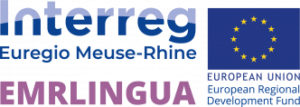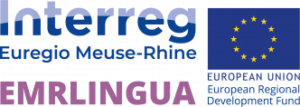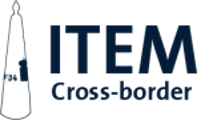Promoting knowledge of the so-called "neighboring languages" in the Euregio Meuse-Rhine

Promoting knowledge of the so-called “neighbouring languages” in the Euregio Meuse-Rhine
The INTERREG V-A project EMR-Lingua runs from 2021-2023 and has the overarching goal of promoting knowledge of the so-called “neighbouring languages” (Dutch, French, and German) in the Euregio Meuse-Rhine. To this end, a Euregional Centre for Neighbouring Languages has been established.
This project is co-financed by the Interreg V-A Euregion Meuse-Rhine programme of the European Union, based on the European Regional Development Fund (ERDF). In the Euregio, several initiatives to promote the knowledge of neighbouring languages have been developed over the years. The goal of the Centre is to bring these initiatives together, and to stimulate connections and cooperation between them, so that a central contact point emerges for schools and other interested parties. For instance, the Centre will bring together and further develop existing digital learning material, it will manage the school labels ‘Euregioschool’ and ‘Euregioprofielschool’, and it will support schools in finding partners for exchange projects. As a project partner, ITEM contributes to this Interreg project in two ways. First of all, ITEM (Susanne Sivonen and Dorien Coppens) will make an analysis of legal obstacles for teachers working in a neighbouring country (within the Euregio Meuse-Rhine). Secondly, ITEM (Dr. Daan Hovens) will write a report on existing needs, bottlenecks, and practices regarding language and intercultural education at secondary schools.
Watch Daan and Susanne’s video on YouTube
Legal and administrative obstacles in the mobility of secondary school teachers in the Euregio Meuse-Rhine (EMR)
Susanne Sivonen & Dorien Coppens
The report presents a detailed assessment of legal and administrative obstacles for secondary school teachers who (wish to) work on the other side of a national or linguistic border within the Euregio Meuse-Rhine. Moreover, the report formulates specific policy recommendations regarding how to overcome such obstacles. In the end, these recommendations can serve to promote the exchange of teaching staff in the euregion, for instance for the purpose of language teaching and/or to facilitate bilingual education practices such as Content and Language Integrated Learning (CLIL) and Language Immersion.
Factsheets:
Executive summaries:
Connecting through education in a border region. Why schools in the Meuse-Rhine Euroregion do/do not invest in neighbour language education and Euroregional school activities
Daan Hovens
This research report addresses the question why secondary schools in the Meuse-Rhine Euroregion do/do not invest in neighbour language education (German, French, Dutch) and Euroregional school activities (such as Euroregional trips and pupil exchanges). This report looks at what political and social patterns, needs and bottlenecks can help explain (the absence of) certain investments and provides specific recommendations to “make neighbour language education sustainable” in the Euroregion, specifically in secondary education.

This project is co-financed by the Interreg V-A Euregion Meuse-Rhine programme of the European Union, based on the European Regional Development Fund (ERDF).

